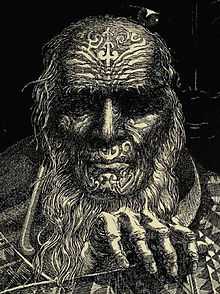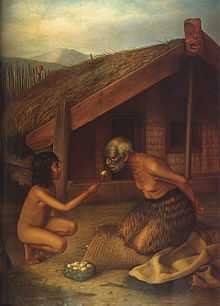Tohunga
In the culture of the Māori of New Zealand, a tohunga is an expert practitioner of any skill or art, either religious or otherwise. Tohunga include expert priests, healers, navigators, carvers, builders, teachers and advisors. "A tohunga may have also been the head of a whanau but quite often was also a rangatira and an ariki".[1] The equivalent and cognate in Hawaiian culture is kahuna.
Callings and practices

There are many classes of tohunga (Best 1924:166) including:
- Tohunga ahurewa: highest class of priest
- Tohunga matakite: foretellers of the future
- Tohunga whakairo: expert carvers
- Tohunga tātai arorangi: experts at reading the stars
- Tohunga kōkōrangi: expert in the study of celestial bodies (astronomer)
- Tohunga tārai waka: expert canoe builders
- Tohunga wetereo: expert in the language (linguist)
- Tohunga tā moko: expert in tā moko (tattooist)
- Tohunga mahi toi: expert artist
- Tohunga tikanga tangata: expert in the study of humans (anthropologist)
- Tohunga o Tumatauenga: expert in weapons or war party chaplain
- Tohunga kiato: lowest class of priest
Each tohunga was a gifted spiritual leader and possessed the natural ability of communicating between the spiritual and temporal realms through karakia (prayers), pātere (chants) or performing waiata (songs) that had been passed down to them by tohunga before them. However, their rites were mainly in the specific fields in which they practiced, as outlined above.
Practices and knowledge
Tohunga held knowledge of most spiritual and temporal rites and knowledge in general were passed down through many generations by oral communication at wananga (places of learning/schools). Tools they also used were taonga pūoro for the purpose of calling on divine intervention or assistance from the gods.
Although Māori revered tohunga with high respect for their knowledge, skill or craft and practice, there was some uncertainty regarding their sources by which the early European settlers misunderstood and were regarded by Christian beliefs as a dangerous cult or even witchcraft when tohunga would touch on fear "of magic" of which the Christians believed and have long accused Māori tohunga of creating in their work.
Many tohunga declined to pass on their oral traditions after the Tohunga Suppression Act 1907 was enforced in New Zealand so this left the Māori people bereft of much of their traditional base, beliefs and practices for a long time until the Act was repealed in 1962. By this time, much of the language and traditions had been either corrupted or lost with tohunga that had long since died. There is no doubt that the enforcement of Christianity together with the Tohunga Suppression Act has played a dominant role in the obstruction of traditional Māori healing practises.
The concepts of mātauranga Māori (indigenous Māori knowledge) relate to the continuum of tohungatanga (priestly knowledge), the loss of which has left many scars on the holistic health and wellbeing of the Māori people, the land, the waters, the air, the bush, and the wildlife. The preservation and transmission of tohunga (high priest) knowledge was and is vital to sustain the future generations of all living and non-living things in the metaphysical world of Māori.
Whatever the overt intentions, there was a paradigm of the time amongst English colonists that Māori were a "lost race", the effect of banning the practices of spiritual and cultural leaders was that it hastened the assimilation of Māori. Fortunately although in hiding, there were few kaumatua and kuia (elders) that held steadfast and true to Māori traditions and continued to orally communicate their knowledge through the generations.
One observation to the survival of tohungatanga was the insignificance of the "female tohunga‟ perspective and yet women were the "most powerful tohunga" as they had a direct lineage and link to Te Ira Atua (spiritual realm of the gods) and are a class that have been ignored in any literature until now.
Tohunga under tapu

Tapu was one of the most deeply ingrained beliefs and religious customs of the Māori. The word tapu may be translated as sacred or forbidden, but the Māori tapu has a host of variations. There was a personal tapu and local tapu; tapu of one kind or another faced the Māori everywhere. It often served a purpose similar to some of the Jewish laws of prohibition and quarantine.
Priests, or tohungas, were imbued with the mysterious essences of the tapu because of their knowledge of ancient and potent karakia (incantations), religious ceremonies and their office as mediums of communication with the dread atua (gods). All ariki (high chiefs) also had a strong personal tapu which prevented any common person eating out of the same food basket or using anything belonging to the chief.
The remains of the sacred dead and all connected therewith were highly tapu and anyone who had been engaged in handling the dead or bones of the dead would be extremely tapu and would not dare to touch food with the hands. Consequently such persons had to be fed in the manner shown in the painting here. This was painted from life at an old-time pa (village) in the Wanganui district. The outer pallisaded fence of the pa, with its roughly carved posts, usually totara, is shown in the background. The tohunga is kneeling on mats in front of a raupo whare (house) in a remote corner of the settlement. This is his temporary dwelling, for to enter the other buildings would infect others with tapu.
See also
References
- ↑ Mead, S. M. (1997). Landmarks, bridges and visions: Essays. Wellington, New Zealand: Victoria University Press. (p. 197).
- Best, Elsdon, Māori Religion and Mythology. Dominion Museum, Bull. 10, 1924
- T. R. Hiroa (Sir Peter Buck), The Coming of the Māori. Second Edition. First published 1949. Wellington: Whitcombe and Tombs) 1974.